2017 MERCEDES-BENZ E-CLASS ESTATE brake
[x] Cancel search: brakePage 195 of 585

function is activated via
theM ercedes
me connect weba pp. The elect
ricp arkin gb rake is applied if thet rans‐
mission is in position jand one of thef ollow‐
ing condition sisfulfilled:
R The engin eisswitched off.
R The seat belt tongu eisn otinser tedint he
seat belt buckle of thed rive r's seat and the
driver's door is opened.
% Toprev ent application: pull theh andle of the
electric parking brake.
In thef ollowing situations, thee lectric parking
brak eisa lso engaged:
R ActiveD ista nce Assi stant DI STRO NIC is
bringing thev ehicle toas tandstill.
R The HOL Dfunction is keeping thev ehicle sta‐
tionar y.
R ActiveP arking Assis tiskeeping thev ehicle
st ationar y. This is onl
ythe case if one of thef ollowing con‐
ditions is also fulfilled:
R The engine is switched off.
R The seat belt tongu eisn otinser tedint he
seat belt buckle of thed rive r's seat and the
driver's door is opened.
R Ther eisas ystemm alfunction.
R The po wersupply is insuf ficient.
R The vehicle is stationar yfor alengt hyperiod.
When thee lectric parking brak eisapplied,
the ! indicator lam plights up in thei nstru‐
ment clus ter.
The electric parking brak eisnotautomatically
applied if thee ngine is switched of fbythe ECO
st art/ stop function.
Electric parking brak efunction (releasing
automatically)
The electric parking brak eisreleased when the
fo llowing condition sarefulfilled:
R The engin eisrunning.
R Thes eatb eltt ongue is inser tedi ntot he seat
belt buckle of thed rive r's seat. R
The transmission is in position hork and
yo ud epress thea ccelera torp eda lory ou
shif tfromt ransmission position jtoh or
k.
R Ifth et ransmission is in position k,thetail‐
ga te mus tbec losed.
If th es eat belt tongu eisn otinser tedi ntot he
seat belt buckle of thed rive r's seat, thef ollow‐
ing condition smustbef ulfilled:
R The driver's door is closed.
R Youm ovet he transmission out of transmis‐
sion position joryouh ave prev iously
driven fasterthan 3k m/ h.
R Ifth et ransmission is in position k,thetail‐
ga te mus tbec losed.
If th ee lectric parking brak eisreleased,
the ! indicator lam pinthe instrument clus‐
te rg oes out. 19 2
Driving and pa rking
Page 196 of 585

App
lying or releasing thee lectric pa rking
brak emanually
Applying #
Push handle 1.
The ! indicator lam pappear sinthe
instrument clus ter. %
The electric parking brak eisonlys ecurely
applied if thei ndicator lam pislit continu‐
ously.
Re leasing #
Swit chthei gnition on. #
Pull handle 1.
The ! indicator lam pinthe instrument
clus terg oes out.
Emer gency braking #
Press and hold handle 1.
When thev ehicle has been braked to a
st andstill, thee lectric parking brak eis
applied. The !indicator lam pappear sin
th ei nstrument clus ter. Information on de
tectin gdamag eona
pa rked vehicle If
ac ollision is de tected whe nthe tow- aw ay pro‐
te ction is acti vatedonal ockedv ehicle, youw ill
re cei venotification:
R onyour smartphone R
inthem ultimedia sy stem when yous wit ch
on thei gnition
Yo uw illrecei veinformatio nabout thef ollowing:
R thea reaoft hevehicle that ma yhave been
damaged
R thef orce of thei mp act
The following situations can lead toinadver tent
acti vation:
R thep arke dv ehicle is mo ved, e.g. in adouble-
dec kerg arage
% Deactivat etow -awa yp rotection in order to
pr eve nt inadver tent acti vation. If youd eacti‐
va te tow- aw ay protection, damag edetection
will also be deacti vated.
Sy stem limitations
De tection ma yberestricted in thef ollowing sit‐
uations:
R thev ehicle is damaged without impact, e.g. if
an outside mir rorist orno ffor thep aint is
damaged byakey
R an impact occur satlowspeed Drivin
gand parking 19 3
Page 198 of 585
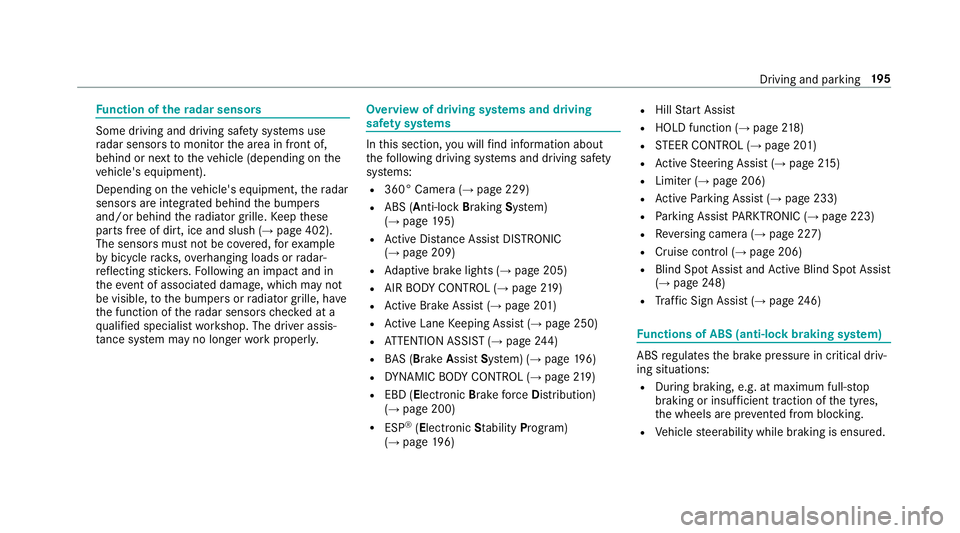
Fu
nction of ther adar senso rs Some driving and driving sa
fety sy stems use
ra dar sensor stomonitor thea reainf ront of,
behind or next tothev ehicle (depending on the
ve hicle's equipment).
Depending on thev ehicle's equipment, ther adar
senso rsarei ntegrated behind theb umpers
and/or behind ther adiator grille. Keep these
parts free of dirt, ice and slush (→ page402).
The sensor smustn otbe co vered, fore xamp le
by bicycle rack s, ove rhanging loads or radar-
re flecting sticke rs.F ollowing an impact and in
th ee vent of associated dama ge,w hic hm aynot
be visible, totheb umper sorradiator grille, ha ve
th ef unction of ther adar senso rscheckedata
qu alified specialis tworks hop. The driver assis‐
ta nce sy stem ma ynolonger workproperly. Overvie
wofdriving sy stems and driving
saf etys ystems In
this section, youw illfind informatio nabout
th ef ollowing driving sy stems and driving saf ety
sy stems:
R 360° Camer a(→pag e229)
R ABS (A nti-lock Braking System)
(→ pag e195)
R ActiveD ista nce Assi stDISTRONIC
(→ page 209)
R Adaptiv ebrake light s(→pag e205)
R AIRB ODYC ONTROL (→ page219 )
R ActiveB rake Assi st (→pag e201 )
R ActiveL aneK eeping Assis t(→pag e250)
R ATTENTION ASSIS T(→ pag e244)
R BAS(Brake Assist System) (→ page196)
R DYNA MIC BODY CONTROL (→ page219 )
R EBD ( Electronic Brakeforce Distribution)
(→ pag e200)
R ESP ®
(Elect ronic Stability Program)
(→ pag e196) R
Hill StartA ssist
R HOL Dfunction (→ page218)
R STEER CONTROL (→ page 201)
R ActiveS teering Assis t(→ pag e215 )
R Limi ter( →pag e206)
R ActiveP arking Assis t(→pag e233)
R Parking Assis tPARKTRONIC (→ page 223)
R Reversing camer a(→pag e227)
R Cruise control (→ page206)
R Blin dSpotA ssis tand ActiveB lind Spo tAssist
( → pag e248)
R Traf ficS ign Assi st (→pag e246) Fu
nctions of ABS (anti-loc kbraking sy stem) AB
Sr egulates theb rake pressur eincritical driv‐
ing situations:
R During braking, e.g. at maximum full-s top
braking or insuf ficient traction of thet yres,
th ew heels ar epreve nted from blocking.
R Vehicle steerability while braking is ensured. Driving and parking
19 5
Page 199 of 585
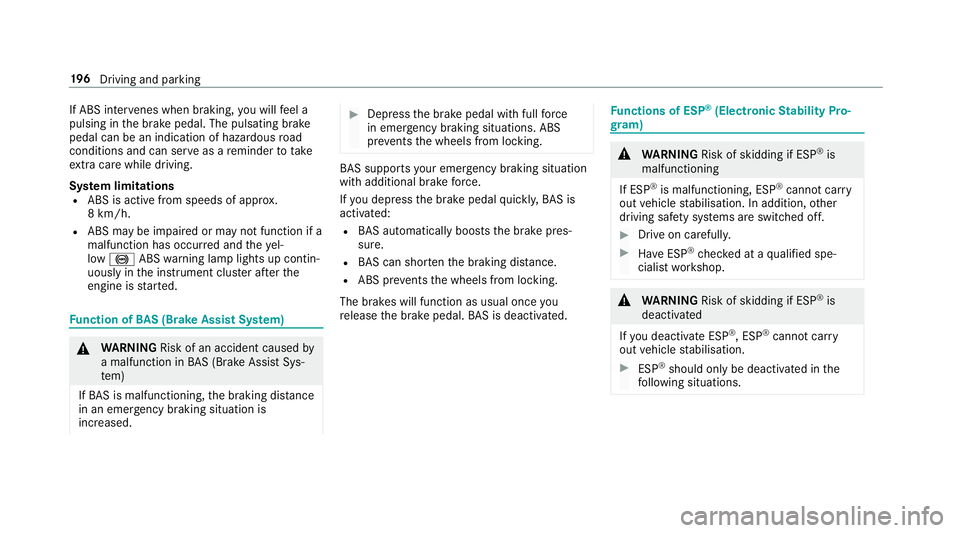
If ABS inter
venes when braking, youw illfeel a
pulsing in theb rake pedal. The pulsating brake
pedal can be an indication of hazardous road
condition sand can ser veas areminder totake
ex trac arew hile driving.
Sy stem limitations
R ABSisa ctivefroms peeds of appr ox.
8k m/h.
R ABS ma ybeimpaire dorm aynotfunction if a
malfunction has occur reda nd they el‐
low ! ABSwarning lam plight supc ontin‐
uousl yinthe instrument clus tera fter the
engine is star ted. Fu
nction of BAS(Brak eAssis tSystem) &
WARNING Risk of an accident caused by
am alfunctio ninBAS (Brak eAssistSys‐
te m)
If BA Sism alfunctioning ,the braking dis tance
in an emergency braking situatio nis
increased. #
Dep ress theb rake pedal wit hfull force
in emer gency braking situations. ABS
pr eve nts thew heels from locking. BA
Ss uppo rtsy our emer gency braking situation
wit ha dditional brak eforce.
If yo ud epress theb rake pedal quickl y,BA Sis
acti vated:
R BASa utomatically boosts theb rake pres‐
sure.
R BASc an sho rten theb raking dis tance.
R ABS pr events thew heels from locking.
The brakes will function as usual oncey ou
re lease theb rake pedal. BASisd eactivated. Fu
nctions of ESP ®
(Electronic Stability Pro‐
gr am) &
WARNING Risk of skidding if ESP ®
is
malfunctioning
If ESP ®
is malfunctioning ,ESP ®
canno tcarry
out vehicle stabilisation .Inaddition ,other
driving saf etys ystems ar eswitched off. #
Driv eonc arefull y. #
Have ESP ®
ch eckedataq ualified spe‐
cialis tworks hop. &
WARNING Risk of skidding if ESP ®
is
deactivated
If yo ud eactivat eESP®
,E SP ®
canno tcarry
out vehicle stabilisation. #
ESP ®
shoul donly be deacti vatedint he
fo llowing situations. 19 6
Driving and pa rking
Page 200 of 585
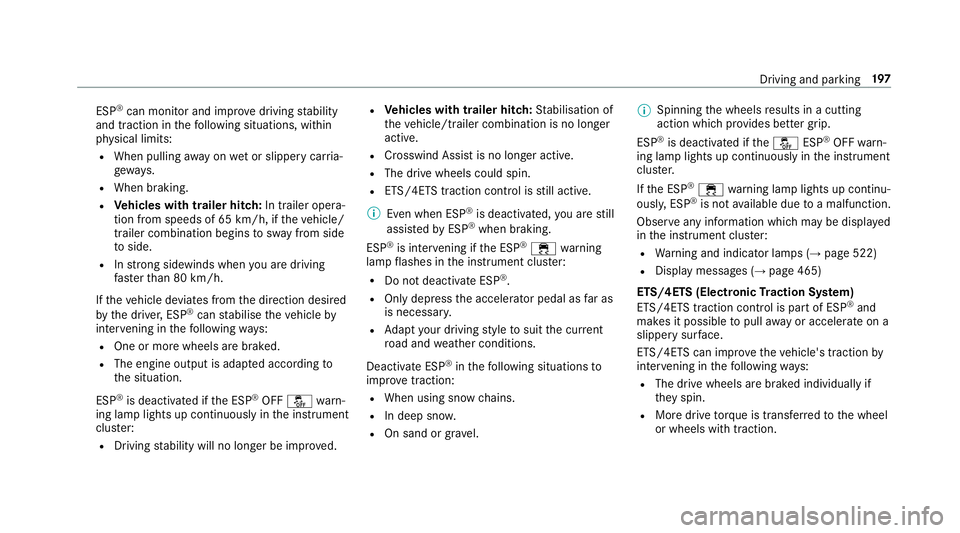
ESP
®
can moni tora nd impr ovedriving stability
and traction in thef ollowing situations, within
ph ysical limits:
R When pulling away on wetors lipper ycarria‐
ge wa ys.
R When braking.
R Vehicles with traile rhitch: In trailer opera‐
tion from speeds of 65 km/h ,ifthevehicle/
trailer combination begins tosw ay from side
to side.
R Instro ng sidewinds when youa redriving
fa ster than 80 km/h.
If th ev ehicle deviates from thed irection desired
by thed rive r,ESP ®
can stabilise thev ehicle by
inter vening in thef ollowing ways:
R One or mor ewheels ar ebrake d.
R The engine output is adap teda ccording to
th es ituation.
ESP ®
is deactivated if theE SP®
OFF å warn‐
ing lam plight supc ontinuousl yinthe instrument
clus ter:
R Driving stabilit ywill no lon gerbei mprove d. R
Vehicles with traile rhitch: Stabilisation of
th ev ehicle/trailer combinatio nisnol onger
active.
R Crosswind Assis tisnolonger active.
R The driv ewheels could spin.
R ETS/4ETS traction control is still active.
% Even when ESP ®
is deactivated, youa restill
assis tedbyE SP®
when braking.
ESP ®
is inter vening if theE SP®
÷ warning
lam pflashes in thei nstrument clus ter:
R Do no tdeacti vate ESP ®
.
R Only depress thea ccelera torp eda lasf ar as
is necessar y.
R Adapty our driving styletos uitthec urrent
ro ad and weather conditions.
Deactivat eESP®
in thef ollowing situations to
impr ovetraction:
R When using sno wchains.
R In deep sno w.
R On sand or gr avel. %
Spinning thew heels results in acutting
action whic hprovide sbette rg rip.
ESP ®
is deactivated if theå ESP®
OFF warn‐
ing lam plight supc ontinuousl yinthe instrument
clus ter.
If th eE SP®
÷ warning lam plight supc ontinu‐
ousl y,ESP ®
is no tavailable due toam alfunction.
Obse rvea nyinformation whic hmaybe displa yed
in thei nstrument clus ter:
R Warning and indicator lamps (→ page522)
R Displa ymessages (→ page465)
ETS/4ET S(Electronic Tractio nSystem)
ETS/4E TStraction control is pa rtof ESP ®
and
makes it possible topull away or accelerat eona
slipper ysurface.
ETS/4ET Scan impr ovethev ehicle's traction by
inter vening in thef ollowing ways:
R The driv ewheels ar ebrake di ndividually if
th ey spin.
R Mor edrive torque is transferred tothew heel
or wheels wit htraction. Driving and parking
197
Page 203 of 585
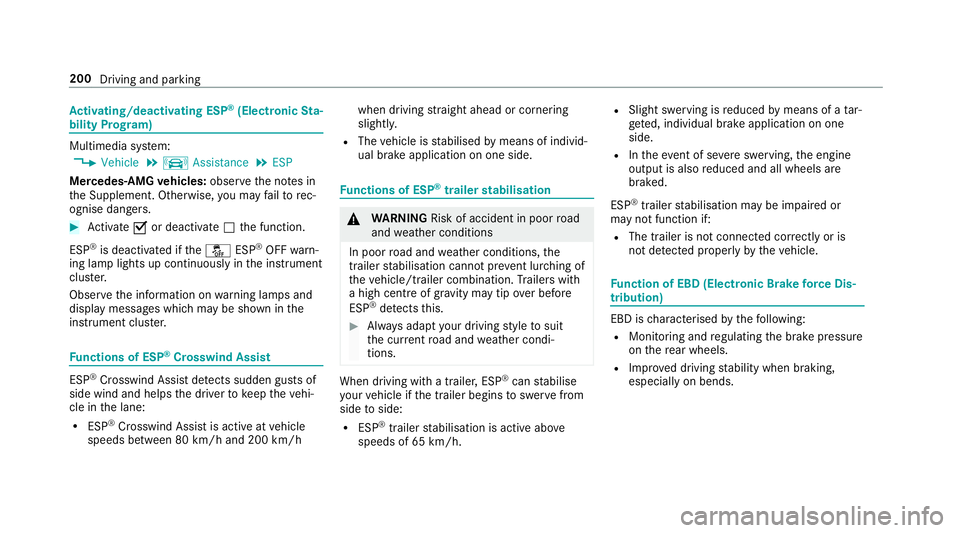
Ac
tivating/deactivatin gESP®
(Electronic Sta‐
bility Prog ram) Multimedia sy
stem:
, Vehicle .
k Assistance .
ESP
Mercedes‑AMG vehicles: observet he no tesin
th eS upplement .Otherwise, youm ayfailto rec‐
ognise dangers. #
Activate Oor deacti vate ª thef unction.
ESP ®
is deactivated if theå ESP®
OFF warn‐
ing lam plight supc ontinuousl yinthe instrument
clus ter.
Obser vethei nformation on warning lamps and
displa ymessages whic hmaybe shown in the
instrumen tclus ter. Fu
nctions of ESP ®
Crosswind Assist ESP
®
Crosswind Assis tdetects sudden gusts of
side wind and helps thed rive rtok eepthev ehi‐
cle in thel ane:
R ESP ®
Crosswind Assis tisactiveatv ehicle
speeds between 80 km/h and 200 km/h when driving
stra ight ahead or cornering
slight ly.
R The vehicle is stabilise dbym eans of individ‐
ualb rake application on one side. Fu
nctions of ESP ®
trailer stabilisation &
WARNING Risk of accident in poo rroad
and weather conditions
In poor road and weather conditions, the
traile rstabilisation canno tpreve nt lu rching of
th ev ehicle/trailer combination. Trailer swith
ah igh centr eofgravity ma ytipove rbefore
ESP ®
de tects this. #
Alw aysa dap tyour driving styletos uit
th ec urrent road and weather condi‐
tions. When drivin
gwithat railer ,ESP ®
can stabilise
yo ur vehicle if thet railer begins toswer vefrom
side toside:
R ESP ®
trailers tabilisation is activ eabove
speeds of 65 km/h. R
Slight swerving is reduced bymeans of atar‐
ge ted, individual brak eapplication on one
side.
R Inthee vent of se vere swerving, thee ngine
output is also reduced and all wheels are
braked.
ESP ®
trailer stabilisation ma ybeimpaired or
ma ynotfunction if:
R The trailer is no tconnec tedc orrectly or is
no td etected properly bythev ehicle. Fu
nction of EBD (Electronic Brak eforce Dis‐
tribution) EB
Disc haracterised bythef ollowing:
R Monitoring and regulating theb rake pressure
on ther ear wheels.
R Impr oveddriving stabilit ywhen braking,
especiall yonb ends. 200
Drivingand parking
Page 204 of 585
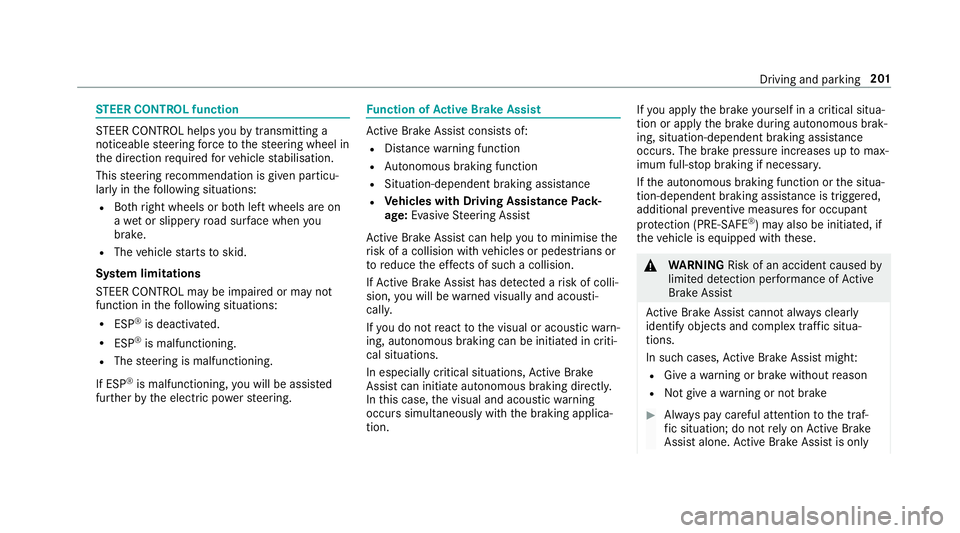
ST
EER CONT ROLfunction ST
EER CONTROL help syou bytransmitting a
noticeable steering forc etot hesteering wheel in
th ed irection requ ired forv ehicle stabilisation.
This steering recommendation is given pa rticu‐
larly in thef ollowing situations:
R Both right wheels or bo thleftw heels ar eon
aw etor slippe ryroad sur face whe nyou
brake.
R The vehicle starts toskid.
Sy stem limitations
ST EER CONTROL ma ybeimpairedorm aynot
function in thef ollowing situations:
R ESP ®
is deactivated.
R ESP ®
is malfunctioning.
R The steering is malfunctioning.
If ESP ®
is malfunctioning, youw ill be assis ted
fur ther by thee lectric po wersteering. Fu
nction of Activ eB rake Assi st Ac
tiveB rake Assi stconsi stso f:
R Distance warning function
R Autonomous braking function
R Situation-dependent braking assi stance
R Vehicles with Drivin gAssistanc ePack‐
age: Evasi veSteering Assist
Ac tiveB rake Assi stcan hel pyou tominimis ethe
ri sk of acollision wit hvehicles or pedestrians or
to reduce thee ffects of suc hacollision.
If Ac tiveB rake Assi sthas de tected arisk of colli‐
sion ,you will be warned visually and acousti‐
cally.
If yo udon otreact tothev isual or acoustic warn‐
ing, autonomous brakin gcan be initiated in criti‐
cal situations.
In especially critical situations ,Activ eBrake
Assi stcan initia teautonomous brakin gdirect ly.
In this case, thev isual and acoustic warning
occur ssimultaneousl ywitht he braking applica‐
tion. If
yo ua ppl ythe brak eyourself in acritical situa‐
tio nora pplythe brak eduring autonomous brak‐
ing, situation-dependen tbraking assis tance
occu rs.T he brak epressur eincreases up tomax‐
imum full-s topb raking if necessar y.
If th ea utonomous braking function or thes itua‐
tion-dependen tbraking assis tance is trig gered,
additional pr eventiv emeasures foro ccupant
pr otection (PRE-SAFE ®
)m ayalso be initiated, if
th ev ehicle is equipped wit hthese. &
WARNING Risk of an accident caused by
limited de tection per form anc eofA ctive
Brak eAssist
Ac tiveB rake Assi stcanno talway sc learly
identify objects and compl extraf fics itua‐
tions.
In su chcases, ActiveB rake Assi stmight:
R Giveaw arning or brak ewithout reason
R Notgiveaw arning or no tbrake #
Alw aysp aycareful attention tothet raf‐
fi cs ituation; do no trely on ActiveB rake
Assi stalone. ActiveB rake Assi stis only Drivin
gand parking 201
Page 207 of 585

Cancelling
abrake application of Active
Brak eAssist
Yo uc an cancel abrake applicatio nofActive
Brak eAssistat an ytimeb y:
R Fullyd epressin gthe accelerator pedal or
wit hk ickdown.
R Vehicles without Drivin gAssistanc epack‐
age: releasing theb rake pedal
Ac tiveB rake Assi stma ycancel theb rake appli‐
cation when one of thef ollowing condition sis
fulfilled:
R Youm anoeuv retoavoid theo bstacle.
R The reis no longer arisk of collision.
R An obs tacle is no longer de tected in front of
yo ur vehicle.
Evasiv eSteering Assis t(onl yvehicles with
Driving Assistan cePackage)
Evasi veSteering Assis thas thef ollowing charac‐
te rist ics:
R Can de tect stationar yorcrossing pedes‐
trians. R
Can assis tthe driver wit hadditional steering
assis tance if it de tects aswerving manoeu‐
vre.
R Canbea ctivatedbyana bruptsteering mo ve‐
ment during aswerving manoeuvre.
R Cana ssistduring swerving and stra ightening
of thev ehicle.
R Can react from aspee dofa pproximately
20 km/h up toas pee dofa pproximately
70 km/h.
Yo uc an pr eventthea ssis tance at an ytime by
activel ysteering. &
WARNING Risk of an accident despi te
Evasiv eSteering Assist
Evasiv eSteering Assis tcann otalw aysc learly
identify objects and comple xtraffic situa‐
tions.
In addition ,the steering suppor tofEvasive
St eering Assis tisgenerallyn otsufficien tto
avo idac ollision. In suc
hcases Evasiv eSteering Assis tcan:
R giveanu nnecessar ywarning or pr ovide
assis tance
R notg iveaw arning or no tprovide assis‐
ta nce #
Alw aysp aycareful attention tothet raf‐
fi cs ituation; do no trely on Evasive
St eering Assis talone. #
Beready tobrak eand take evasive
action ,ifnecessar y. #
Preve ntthea ssis tance byactivel ysteer‐
ing in non-critical driving situations. #
Driv eatana ppropriat espeed if pedes‐
trians ar eclose tothep athofy ourvehi‐
cle. Also obser
vethes ysteml imitations of Evasive
St eering Assist. 204
Driving and parking